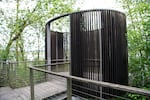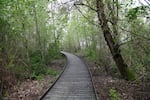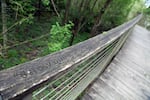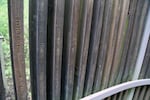So many design stories originate on desktops and drafting tables. Maya Lin's Bird Blind is one that must be experienced with hiking boots on.
During Design Week Portland, the Confluence Project offered a guided hike to see the bird blind world-renowned designer Maya Lin created for the Sandy River Delta.

Constructed in 2008, Maya Lin's Bird Blind lies tucked away in the Sandy River Delta. It's one of five completed installations by the Confluence Project.
April Baer / OPB
We had an early tour, guided by biologist Bill Weiler of the Sandy River Basin Watershed Council, Confluence Project executive director Colin Fogarty, and designer Dylan Woock.
Serving as the gateway to the Columbia River Gorge, the delta stretches across 1,500 acres of upland deciduous forest. The terrain is flat, cut through with channels of the Sandy River. There’s a huge, well-used dog park here, but if you know where to go, you can find a spectacularly quiet corner.
The peaceful landscape of the Sandy River Delta hides a rich and marred history. It was a place where native people visited for thousands of years to gather things like stinging nettles for fishnets and camas roots for sustenance. A hundred years ago, cattle grazed here. But then in the 1940s, an aluminum plant was built directly west, with devastating environmental consequences.
In the 1990s, the land came to the U.S. Forest Service and since then enormous sweat equity has gone into bringing the delta back.
“This is a redemption story,” Fogarty said. “It’s a multi-year, multimillion-dollar restoration project to bring this 1,500 acres back to what it once was.”
This project joined the efforts of the U.S. Army Corps of Engineers, the Oregon Guard, and Friends of Trees, among others.

A wooden walkway draws visitors into the blind.
April Baer / OPB
The dam blocking part of the river was removed, making way for salmon and smelt. A new parking lot was laid at the trailhead. Volunteers removed invasive plant species and native trees were replanted.
In 2004, The Confluence Project kicked off with the goal of connecting people with places in the Columbia Basin. When Confluence's renowned artist and designer Maya Lin was thinking about a way to immerse people in the Sandy Delta, Fogarty said she went back to what Lewis and Clark noticed as they camped just across the Columbia.
Related: Hiking Portland's Wildwood Trail In 5 Parts
“So when Lewis and Clark were here, they were tired and hungry, and all they wanted to do was sleep,” Fogarty said. “And they couldn’t sleep because there were so many birds, and they were so loud. And Clark called them ‘horrid.’ So we’re 20 minutes from downtown Portland. Could you imagine today camping here, and hearing so many birds that you couldn’t sleep?”
Even with species lost since the expedition in 1805, the Audubon Society of Portland calls this a premier destination for birding, especially in late spring: warblers, buntings, orioles and cuckoos love this place.
To get to the the Bird Blind, you pass through an array of alders and cottonwoods.
“It was designed to be something that you stumble upon, something you’re not necessarily planning to do, but suddenly you have a moment,” Fogarty said.
And that’s pretty much how Dylan Woock found it.
“The leadup to the blind is a very gradual curve,” he said. “As you approach the blind there’s this sharp 90-degree righthand turn that breaks that nice harmony of the curve. It makes you stop, turn, and it kind of invites you to walk out into the blind.”
Maya Lin’s Bird Blind is an elliptical shape of metal and black locust wood, formed of 10-foot-tall wooden slats rising up in harmony with the treeline. Follow the wooden walkway in, and you’re hidden from most eyes. Woock said he was very taken by the outdoor room the blind creates within the ecosystem, suspended on struts, now almost obscured by undergrowth, giving the illusion it’s floating five feet off the ground.
“And inscribed on each these slats are the species listed by Lewis and Clark on the journey,” he said. “Going above that is the Latin name, and above that, the status at the time of construction, of that species.”

The railing's inscription reads: "Below quick sand river of the country is low rich and thickly timbered on each side of the river, the islands open and some ponds river wide and emence numbers of fowls flying in every direction such as swan, geese, brants, cranes, stalks, white guls, comerants & plevers & c. Also great numbers of sea otter in the river." — William Clark November 3, 1805
April Baer / OPB
The engraved letters have grown mossy over nine years, but you can still read them. Some are endangered, some threatened, a few are extinct. Woock was almost out of school when he connected with Confluence. He’d been looking for a design project to work on. Confluence was curious what had happened to the species in Lin’s inscriptions since 2008.
"And that was where things got interesting," Woock said. "My initial conception is that there would be a master database. The reality is that there any many regions, subregions and agencies."

Each wooden slat in the blind is inscribed with a species named in Lewis and Clark's journals.
April Baer / OPB
About a hundred hours combing through a dozen different state and federal databases later, Woock had what he came for. Fish have had the hardest time of it. For example, because of habitat loss, heavy fishing and dams, the salmon number is now one-tenth of what it was when the Corps of Discovery passed through. But Woock’s data drag revealed more hopeful updates, too, since 2008.
"Except for the fish," said biologist Bill Weiler, "we’re seeing pretty much populations at the same rate or upticking a little better. The Columbia white-tailed deer is one species proposed for down-listing."
There’s a variety of cuckoo seen near the Blind that hasn’t been in these parts for a long time. While there’s widespread concern among biologists about what resources they’ll have in coming years to monitor species, there’s no small satisfaction in knowing that restorations like this one have yielded results.
Dylan Woock’s data is being added to the Confluence Project’s curriculum for students using the delta as a living lab for the study of species.
The Confluence Project's contributions to Oregon stretch far beyond Bird Blind. They also provide a series of Confluence Story Gatherings where indigenous poets and writers share stories related to the Columbia River. Their next Story Gathering is on May 6 at the Columbia Gorge Discover Center.
Getting There: The Sandy River Delta is just north of I-84 off Exit 18. Driving east, exit the freeway and turn right at the T, go under the overpass and enter the park at the sign. If you're driving west on I-84, take Exit 18 and take an immediate right. At the parking lot, look for the gravel path marked "Confluence." Follow the path for 1.2 miles to reach the Bird Blind.